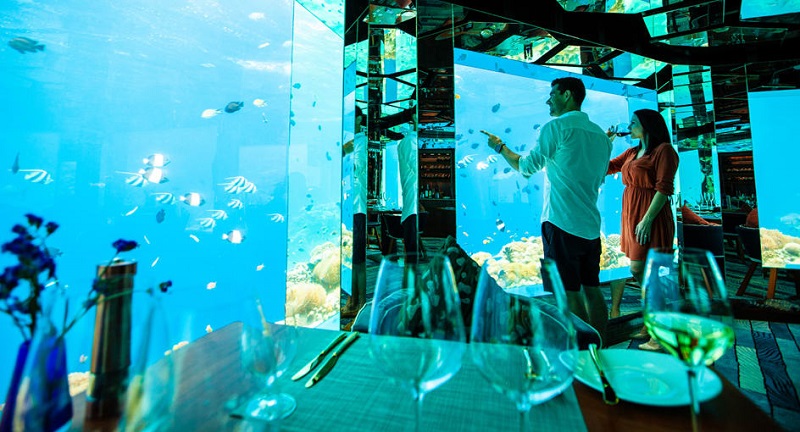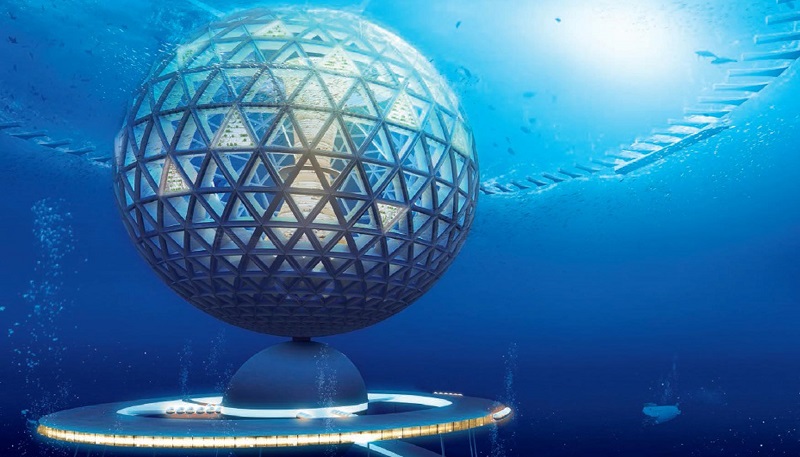ISABEL RUBIO ARROYO | Tungsteno
From the Ithaa Undersea Restaurant in the Maldives to the Transbay Tube, a rail tunnel that connects downtown San Francisco to West Oakland. These are some of the most impressive underwater structures on the planet. But building underwater is no easy task. In addition to the challenge of finding suitable materials, there is the issue of dealing with the water pressure and preventing corrosion of the structures. Some buildings have already been built underwater, but will underwater cities be the next stage?
Museums, hotels and other underwater constructions
A group of 35 human figures walking towards wall at a depth of 15 metres under the sea. This is the scene at the Museo Atlántico, which can be visited by diving off the coast of Lanzarote in Spain. There is also an underwater sculpture park on the Great Barrier Reef in Australia. The aim of its creators is for the figures to be colonised by corals and other endangered marine species. "Art and science are critical partners in the battle against climate change and fundamental in realigning our relationship to the natural world," Jason deCaires Taylor, the sculptor behind the works, told New Scientist.
The Atlantic Museum has 10 different groups of sculptures. Credit: RICI Comunicación
As well as underwater museums and sculpture parks, there are also some underwater hotels, research stations, railway tunnels, restaurants and even a nightclub. In 2018, the Conrad Maldives resort on privately-owned Rangali Island in the Maldives opened a luxury suite submerged some five metres underwater. A night there costs more than $9,000—about €8,230. The Anantara Kihavah Maldives Villas resort, also located in the Maldives, has an underwater restaurant. "Watch sharks, turtles and tropical fish swim by as you savour gourmet dining at its finest," says the hotel's website.
In the Florida Keys National Marine Sanctuary, at a depth of about 18 metres, is the Aquarius Reef Base. It is a laboratory that, according to Florida International University, is used to "study the ocean, test and develop state-of-the-art underwater technology, train specialised divers, and engage a worldwide audience through in-person and virtual experiences."

Anantara Kihavah Maldives Villas resort has an underwater restaurant. Credit: Anantara Kihavah
The challenge of building underwater
When building in water, materials must be used that can withstand water pressure, corrosion and erosion. The most commonly used are concrete, acrylic glass and steel. The company BigRentz explains that "steel, typically encased by concrete, forms a solid structure for underwater buildings." Research published in the journal Construction and Building Materials indicates that underwater concrete is often used to build bridges, dams and other structures.
Another factor to consider is how these cities would be erected. "Today, underwater construction can be accomplished by divers, but professional diving is dangerous, and the types of tools and equipment that can both function underwater and be safely used by divers are fairly limited," says maritime news website gCaptain. For this reason, for underwater construction, attempts are often made to temporarily remove and keep out the water—a technique known as dewatering.
Building underwater brings with it a number of challenges. Credit: Practical Engineering
It is still too early to say whether such a city will be built in the coming decades. Building a fully functional and habitable underwater city presents enormous technical, logistical and economic challenges. Although research and theoretical concepts have been developed, no such city has yet been built on a large scale. The Japanese company Shimizu Corporation, for example, proposed the construction of an underwater city in 2014.
There are also other challenges to living underwater, such as cold temperatures, high pressure and, of course, ensuring that there is enough oxygen for humans. Ideally, construction in very deep waters should be avoided, according to the engineering website Interesting Engineering. The high pressure at these depths would require very thick walls, and residents would have to endure lengthy decompression periods when they returned to the surface.
Despite all these challenges, there are those who aim high and see underwater cities as a solution to the Earth's overpopulation problem. At the moment, the only underwater cities that exist are those that have been submerged underwater over time. According to the US National Oceanic and Atmospheric Administration, sea levels have risen by more than 20 centimetres since 1880. If the trend continues, countries such as the Maldives, China and Bangladesh could lose much of their land area. As Gerd Masselink, a professor in coastal geomorphology at the University of Plymouth in the UK, says, "whether cities or countries disappear depends on whether we as humans are doing something to counteract the threat."
· — —
Tungsteno is a journalism laboratory to scan the essence of innovation.
